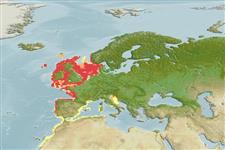>
Gadiformes (Cods) >
Gadidae (Cods and haddocks)
Etymology: Trisopterus: Greek, tris = thrice + Greek, pteron = wing, fin (Ref. 45335).
More on author: Linnaeus.
Environment: milieu / climate zone / depth range / distribution range
Ecología
marino; salobre bentopelágico; oceanodromo (Ref. 51243); rango de profundidad 30 - 100 m (Ref. 3663). Temperate; 62°N - 25°N, 19°W - 16°E
Northeastern Atlantic: from Norway to Morocco incl. British Isles and offshore islands, and Skagerrak, and in the western Mediterranean Ref. 1371, 90172).
Length at first maturity / Tamaño / Peso / Age
Maturity: Lm 22.1, range 21 - 25 cm
Max length : 46.0 cm TL macho / no sexado; (Ref. 7034); common length : 30.0 cm TL macho / no sexado; (Ref. 1371); edad máxima reportada: 4 años (Ref. 1371)
Espinas dorsales (total): 0; Espinas anales 0. Chin barbel well developed. Pelvic fins with slightly elongated anterior rays. Body light brown dorsally, relatively tall, grayish on the sides becoming silvery ventrally, with four or five broad indistinct transverse bars on the sides; a dark blotch at the upper edge of the pectoral-fin base (Ref. 1371). Eye diameter as snout length. Anus lies below the middle of the first dorsal fin (Ref. 35388).
Gregarious fish; immature ones often occur in large schools. Lives mostly on the outer shelf, but moves inshore to depths of 50 m or less for spawning. Feeds on benthic crustaceans but also on small fish, mollusks and polychaetes (Ref. 3663). Caught as a bycatch, used as food fish (Ref. 35388).
Oviparous, sexes are separate (Ref. 205).
Cohen, D.M., T. Inada, T. Iwamoto and N. Scialabba, 1990. FAO species catalogue. Vol. 10. Gadiform fishes of the world (Order Gadiformes). An annotated and illustrated catalogue of cods, hakes, grenadiers and other gadiform fishes known to date. FAO Fish. Synop. 125(10). Rome: FAO. 442 p. (Ref. 1371)
IUCN Red List Status (Ref. 130435)
Warning: mysqli::__construct(): (HY000/1040): Too many connections in /var/www/html/includes/func_getlabel.php on line 46
Can't connect to MySQL database (fbapp). Errorcode: Too many connections
